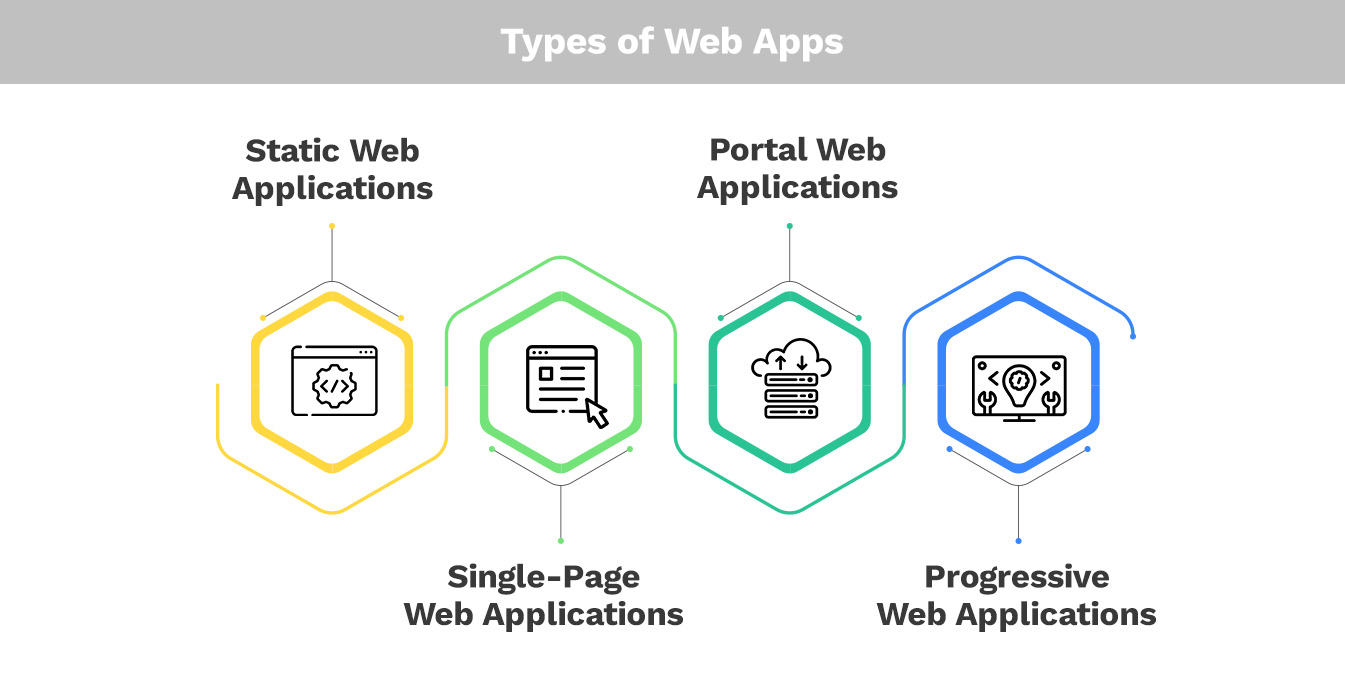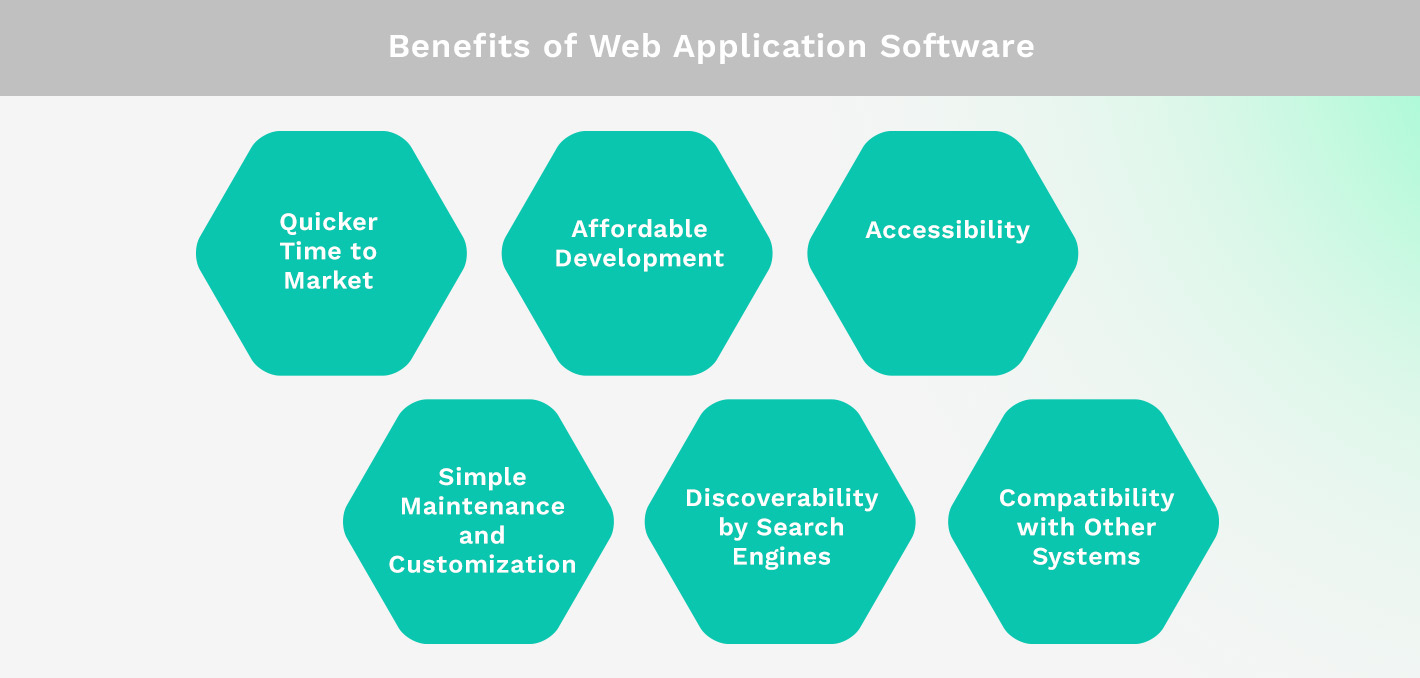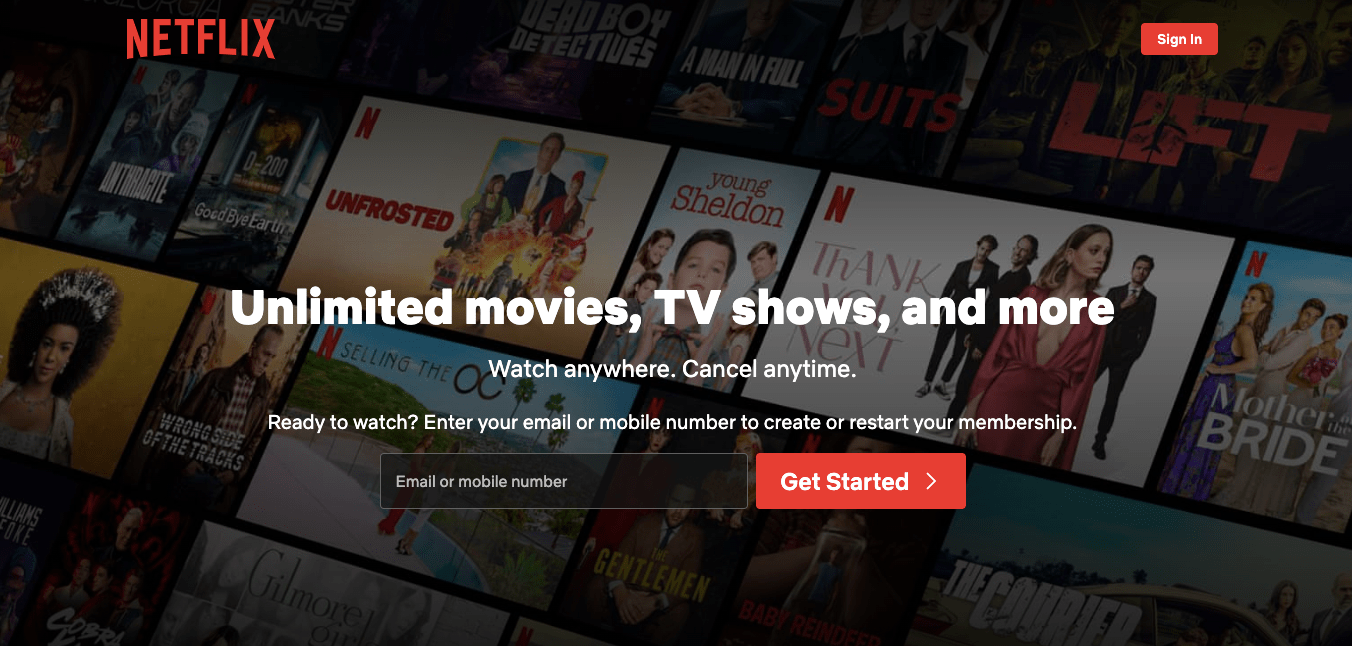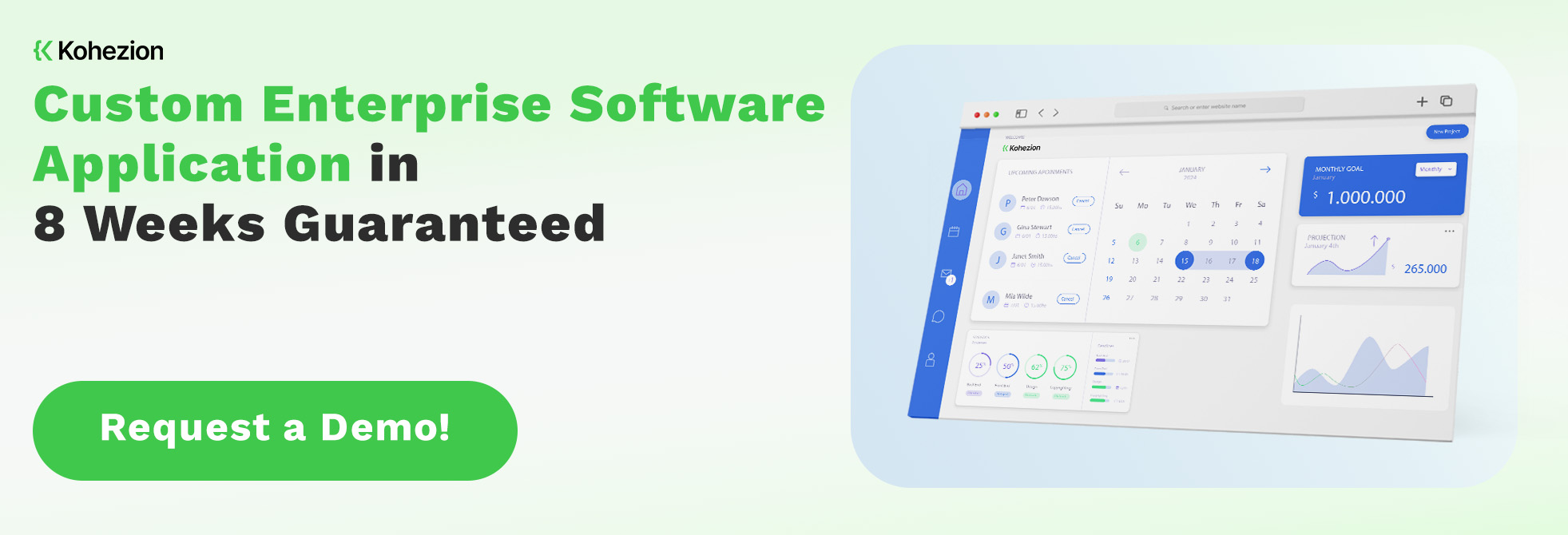innovation into your own projects? Web apps have revolutionized the way businesses and users interact online. Some of the most widely used web apps have millions of users and astronomical profits. For example, Amazon’s current market cap is $1.874 trillion!
Understanding web application software is crucial whether you want to boost customer engagement, make operations smoother, or seek inspiration for your next digital project.
This post discusses everything related to web apps, including types of web apps, examples, and more.
We'll buid your first application for you. At no extra cost.
Let us build your first business application for free. Go from an idea to an application in under 2 weeks.

What Is a Web Application Software?
Unlike traditional software that you need to download and install on your device, web apps run directly in a web browser. This means you can access them from anywhere and on any device with an internet connection. They blend the flexibility of a website with the user experience of a software application to deliver a seamless digital journey.
So, how does a web application work?
Your browser (the client) sends a request to the web app's server. The server processes the request, tapping into databases if needed, and responds with the necessary data. The web app then interprets this data and presents you with the interactive pages you interact with.
Types of Web Apps
Let's explore the four common categories of web applications that cover various online functionalities.
Static Web Applications
Static web applications display the same content for every visitor every time, making them reliable but not interactive. Built with HTML, CSS, and sometimes JavaScript for a touch of animation or interactivity, these applications don't react to user input beyond basic form submissions or hyperlinks.
They are called 'static' because they don't change or adapt in real time to user inputs. The content is pre-written and served 'as is' any time a request is made. To alter the content, a developer must dive into the code, make changes, and then redeploy the application.
Static web apps shine when consistent information delivery is key and dynamic functionality isn't required. Think of the classic 'brochureware' sites or landing pages that display the same message to all visitors, portfolio websites for artists who want to showcase their work, or informational pages that provide contact details or explain terms and services. Due to their simplicity, these apps are easy for software development companies and website administrators to host and typically require less maintenance than their dynamic counterparts.
Even though they can't compete with dynamic web apps, static web apps stand out for their speed and security. Without server-side processing, there's less to go wrong, making them a robust option for content that doesn't need regular updates.
Single-Page Web Applications
Single-Page Web Applications (SPAs) load once, and then everything happens seamlessly within that initial page. They dynamically rewrite the web page with new data from the web server in response to user actions. This eliminates the traditional page reloading after every interaction you might find in a more classic web experience.
With Single-Page Applications, content, images, and data are either loaded upfront or fetched asynchronously, providing a continuous and natural user experience. Think of scrolling through your Facebook feed or working on a Google Doc. It all happens smoothly, without reloading the page, much like a desktop application.
The strength of SPAs lies in their fluidity and responsiveness. They're designed to work without interruption and reflect changes instantly. This makes SPAs especially popular for applications where user experience is crucial, such as social networks, email platforms, and collaboration tools.
Developing an SPA involves heavy JavaScript usage with frameworks like Angular, React, or Vue.js handling the client-side magic. While these frameworks have a lot to offer in terms of performance and user satisfaction, they may require a different approach to SEO and initial loading performance optimization.
Portal Web Applications
The key to the portal web apps’ function is user authentication. You provide credentials, gain entry, and are rewarded with resources tailored just for you. An example of this can be a dashboard you see after logging into a university's website where students and faculty can access grades, course materials, discussion forums, and institutional announcements.
These apps offer a centralized access point to resources that might otherwise be scattered across several websites or platforms, significantly improving user engagement and satisfaction.
Portal web applications are suitable for organizations aiming to provide an inclusive environment for their users to conduct activities securely and efficiently.
Progressive Web Applications
Progressive Web Applications (PWAs) adapt to whichever device or platform you're on - your smartphone, tablet, or desktop environment.
PWAs use modern browser APIs and features to deliver a 'native app-like' performance. They're designed to be fast, reliable, and engaging. With a PWA, you can expect fast load times, the convenience of offline functionality thanks to cached data, and helpful push notifications that keep you engaged and informed.
For example, if you're checking out the Starbucks PWA to order coffee, the experience is smooth even on a spotty network, and you don't have to worry about storage space on your device. Add it to your home screen, and it feels like an app from the app store, only lighter and more flexible.
PWAs are also a boon for businesses, bypassing the need for different versions for various app stores and streamlining the update process. Plus, given their web nature, they're discoverable by search engines.

Benefits of Web Application Software
In this section, we'll discuss the benefits that make web applications valuable assets for businesses and users alike.
Quicker Time to Market
Speed is of the essence when launching a digital product, and web application software plays an important role here. With a quicker time to market, these apps shorten the lengthy processes often associated with native app development. You don’t need to stop for app store approvals or get bogged down in device-specific optimizations because web apps go directly from development to deployment.
This allows you to respond to market demands quickly, iterate based on user feedback, and evolve before your competitors. You can start with a minimum viable product (MVP), test it, and perfect your offering as you grow.
For businesses, this means getting your product to the audience without missing a step, resulting in increased customer satisfaction. It also saves you time and money, which can be redirected into refining your application and improving the user experience.
Affordable Development
Instead of tailoring separate apps for iOS, Android, and other operating systems, web apps enable a one-size-fits-all solution. This unified approach significantly saves development time, resources, and money.
Businesses save on platform-specific developers, the need for specialized tools is reduced, and maintenance costs are lower. Updates are also more cost-efficient since they're rolled out server-side, avoiding the logistical dance of updating various versions across different app stores.
Developing a web application means setting up a single, robust application accessible to all users, regardless of their device. This universal accessibility reduces development costs and widens your potential market without the extra outlay.
Accessibility
Web apps are accessible to anyone with an internet connection and a web browser, regardless of their device. For businesses, this means an expanded market reach. Companies can offer services seamlessly across different user environments, ensuring a consistent and inclusive experience. This increases customer satisfaction and opens doors to new demographics.
People with disabilities also benefit from web applications' adherence to accessibility standards. This ensures a wider audience can use services, which is both ethical and good for business.
In terms of productivity, the accessibility of web applications means workflows don't need to be interrupted. You're never tethered to one location or device, and tasks can be picked up right where they were left off.
Simple Maintenance and Customization
Web applications are remarkably hassle-free to maintain and customize, making them favorites among users and developers. One major selling point is the centralized updates. Unlike traditional desktop applications, where you're prompted to update each time a new version rolls out, web apps refresh and revitalize themselves directly on the server. This means that whenever you access the web app, you're experiencing the latest version.
Developers can push updates, fix bugs, or introduce new features universally, which are instantly available to all users. There is no need to wrangle with multiple versions across various app stores. A single update does the trick, keeping things consistent and cutting down on support time.
Customization comes with similar ease. Web apps often provide user settings that allow you to tweak the user interface and experience to suit your preferences. Whether it's changing themes, modifying layouts, or setting preferences for notifications, these changes are straightforward to implement and can be done on the fly. For businesses, this means less time and money spent on support and maintenance and more opportunities for personalizing services to meet customer needs.
Discoverability by Search Engines
Unlike native apps that rely on visibility in crowded app stores, web applications benefit from the reach and power of search engines. This aligns perfectly with the natural online behavior of searching first, which increases the chances of your app being discovered organically.
Web apps can pull out serious SEO moves, like optimizing keywords, crafting compelling meta descriptions, niche edits and building backlinks to increase search rankings. These SEO strategies cast a wider net for potential users who may be in search of the exact solutions that your web app offers. The spotlight search engines can throw on web applications can help with brand recognition, market penetration, and user acquisition.
Compatibility with Other Systems
The interoperability of web apps with other software systems allows for a more interconnected and streamlined user experience. Thanks to web standards and APIs (Application Programming Interfaces), web applications can communicate and collaborate with other services effortlessly. Whether it's pulling in data from a third-party service, pushing out notifications to different platforms, or integrating with customer relationship management tools, web apps stand out for their ability to play well with others.
For businesses, this means processes that once were siloed and cumbersome can now flow together seamlessly. For example, an e-commerce web app can integrate with a payment gateway to process transactions securely.
This compatibility ensures smooth data exchange and improved functionality. It eliminates the need for clunky workarounds or multiple tools and improves automation, accuracy, and efficiency.

10 Web Application Software Examples
Below, we'll explore ten examples of web application software that demonstrate its diverse applications and functionalities.
1. Kohezion

Kohezion is a web application software that can create business applications without writing a single line of code. Developed for non-technical users but powerful enough for corporate use, it's an online database software that allows businesses to design their own applications tailored to their unique workflow and data management needs.
2. Google Docs

Google Docs eliminates the need for clunky software, allowing document creation, editing, and sharing with nothing more than a web connection. Its easy-to-use interface and ability to collaborate in real-time have introduced a new way for teams to work together efficiently.
3. Facebook

Facebook has evolved into one of the most lauded web application software examples. It has transformed the way people connect and share online. Facebook also doubles as an invaluable business tool through its advertising and community engagement features.
4. Canva

Canva is a go-to graphic design tool for professionals and novices alike. It breaks down the barriers to sophisticated design with templates, images, and intuitive drag-and-drop functionality. Whether you're crafting social media graphics, presentations, or flyers, Canva puts design possibilities at your fingertips. It is widely used by small business owners, marketers, educators, and anyone looking to produce high-quality visual content without the steep learning curve of traditional design software.
5. Instagram

Instagram is a web app synonymous with visual sharing and community building. From its humble beginnings as a photo-sharing platform, it now includes everything from Stories to shoppable posts, allowing users and brands to create a visual narrative that captivates a global audience.
6. Netflix

As a web application, Netflix delivers personalized viewing experiences with various shows, films, and original content tailored to your tastes. It has changed how content is consumed and produced, with an influence that stretches far beyond the screen.
7. Microsoft Office

Microsoft Office has evolved from its desktop origins to become a powerhouse as a web application suite. Microsoft Office Online brings the familiar fleet of Word, Excel, PowerPoint, and more into your browser, facilitating productivity and collaboration without being tied to a single device or location.
8. Uber

Uber's web app puts a chauffeur in your pocket, metaphorically speaking. With a few clicks, this ride-sharing service brings convenient transportation options to your doorstep, changing the face of urban mobility.
9. eBay

eBay remains a top destination for snagging bargains and selling unwanted treasures. Its web app has streamlined the auction and purchasing process, keeping it afloat in the e-commerce sea.
10. Spotify

Spotify offers a vast library of songs and podcasts within a web app that personalizes your listening experience and keeps you grooving all day long.
Build Your Web Application Software with Kohezion
Building a web application is less daunting when you have a partner like Kohezion. With its no-code platform, you don't have to have programming knowledge to transform your ideas into reality. Kohezion can simplify complex processes, enabling you to design custom applications that meet your business needs with minimal fuss.
Conclusion
Web application software offers convenience, efficiency, and connectivity. Choosing the right type of web app and understanding its benefits can propel your project forward and captivate your audience.
Interested to know how Kohezion can help? Contact us, and we will help you build a web app tailored to your business needs.
Start building with a free account
Frequently Asked Questions
A successful web app provides a user-friendly, responsive, and value-driven experience. This is often reflected in high user retention rates and positive feedback. It should serve a clear purpose and meet the specific needs of its intended audience.
First, define your app's purpose and identify your target users. Then, choose a development approach, whether custom coding, a no-code platform like Kohezion, or hiring a development team. Finally, iterate based on user feedback to refine your web app.
A diverse range of industries, including e-commerce, healthcare, finance, education, and entertainment, are adopting web apps to improve customer interaction, optimize operations, and expand their digital presence.
Technologies such as JavaScript frameworks (React, Angular, Vue.js), progressive web apps (PWA), serverless architectures, and cloud services are currently in high demand for developing scalable and efficient web applications.

